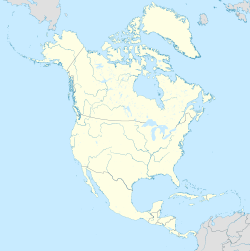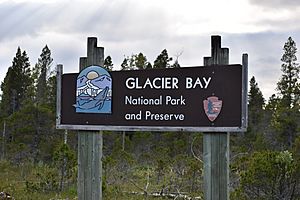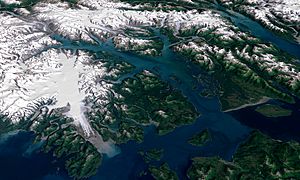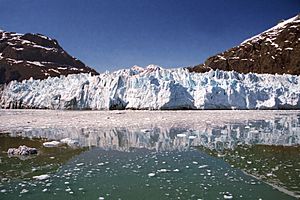Glacier Bay National Park and Preserve facts for kids
Quick facts for kids Glacier Bay National Park and Preserve |
|
|---|---|
|
IUCN Category V (Protected Landscape/Seascape)
|
|
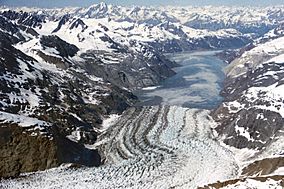
Johns Hopkins Glacier
|
|
| Location | Hoonah-Angoon Census Area and Yakutat City and Borough, Alaska, United States |
| Nearest city | Juneau |
| Area | 3,223,384 acres (13,044.57 km2) |
| Established | December 2, 1980 |
| Visitors | 89,768 (in 2021) |
| Governing body | National Park Service |
| Website | Glacier Bay National Park & Preserve |
| UNESCO World Heritage Site | |
| Part of | Kluane / Wrangell–St. Elias / Glacier Bay / Tatshenshini-Alsek |
| Criteria | Natural: (vii), (viii), (ix), (x) |
| Inscription | 1979 (3rd Session) |
| Extensions | 1992, 1994 |
Glacier Bay National Park and Preserve is a special place in Southeast Alaska, located west of Juneau. It's a national park that protects amazing glaciers, mountains, and wildlife.
The area first became a national monument in 1925 by President Calvin Coolidge. Later, in 1980, it was made into Glacier Bay National Park and Preserve. The "preserve" part allows for some activities like sport hunting, while the "park" part is more strictly protected.
Glacier Bay is also part of a larger UNESCO World Heritage Site. This means it's recognized as important for everyone in the world. The park works with local Tlingit Native American groups to help manage and protect this special land. The park and preserve together cover a huge area of about 3.2 million acres!
Contents
Amazing Geology: How the Land Changes
The land around Glacier Bay has a long and exciting history. It's made of very old rocks, some as thick as 26,000 feet! These rocks include limestone and argillite.
Glaciers have shaped this area for thousands of years. They advanced and retreated many times, leaving behind huge piles of gravel and moraines. These glaciers also carved out valleys and formed lakes. One cool thing about Glacier Bay is how fast the glaciers have moved and changed over time.
This region also has lots of earthquakes. These quakes can cause landslides and even tsunamis. Also, because the heavy glaciers have melted, the land is slowly rising up, a process called post-glacial rebound.
Geography: Exploring the Park's Location
Glacier Bay National Park and Preserve is in the northern part of Alaska's southeastern coast. It sits between the Gulf of Alaska and Canada. The park is home to Mount Fairweather, which is the tallest peak at over 15,300 feet!
A huge icefield called the Brady Icefield covers the Fairweather Range. Glacier Bay itself stretches from Icy Strait all the way to the Canadian border.
There are no roads leading into the park, so you usually arrive by plane or boat. The Alaska Marine Highway ferry can take you to Gustavus, a town near the park entrance. Even without roads, many people visit, mostly by cruise ship. The park limits how many ships can visit each day to protect the environment. Some visitors also enjoy white-water rafting trips on the Alsek River, which flows through the preserve.
Climate: What's the Weather Like?
Glacier Bay National Park has different climate zones, from cool and rainy to cold and snowy. The weather can change quite a bit depending on where you are in the park.
The park's visitor center has a plant hardiness zone of 7a. This means the coldest temperature it usually gets is around 4.2 degrees Fahrenheit (-15.4 degrees Celsius).
| Climate data for Glacier Bay, Alaska, 1991–2020 normals, extremes 1966–present | |||||||||||||
|---|---|---|---|---|---|---|---|---|---|---|---|---|---|
| Month | Jan | Feb | Mar | Apr | May | Jun | Jul | Aug | Sep | Oct | Nov | Dec | Year |
| Record high °F (°C) | 52 (11) |
53 (12) |
55 (13) |
73 (23) |
77 (25) |
82 (28) |
81 (27) |
81 (27) |
71 (22) |
63 (17) |
53 (12) |
53 (12) |
82 (28) |
| Mean maximum °F (°C) | 42.3 (5.7) |
42.9 (6.1) |
46.8 (8.2) |
56.6 (13.7) |
67.3 (19.6) |
74.2 (23.4) |
72.2 (22.3) |
72.3 (22.4) |
62.7 (17.1) |
54.6 (12.6) |
45.9 (7.7) |
42.7 (5.9) |
74.6 (23.7) |
| Mean daily maximum °F (°C) | 31.6 (−0.2) |
33.5 (0.8) |
36.9 (2.7) |
45.5 (7.5) |
54.0 (12.2) |
59.1 (15.1) |
60.7 (15.9) |
60.0 (15.6) |
53.5 (11.9) |
45.0 (7.2) |
36.5 (2.5) |
33.2 (0.7) |
45.8 (7.7) |
| Daily mean °F (°C) | 28.5 (−1.9) |
29.7 (−1.3) |
32.3 (0.2) |
39.3 (4.1) |
46.6 (8.1) |
52.2 (11.2) |
54.6 (12.6) |
54.0 (12.2) |
48.4 (9.1) |
41.0 (5.0) |
33.4 (0.8) |
30.3 (−0.9) |
40.9 (4.9) |
| Mean daily minimum °F (°C) | 25.5 (−3.6) |
26.0 (−3.3) |
27.7 (−2.4) |
33.0 (0.6) |
39.2 (4.0) |
45.3 (7.4) |
48.5 (9.2) |
47.9 (8.8) |
43.3 (6.3) |
37.0 (2.8) |
30.4 (−0.9) |
27.3 (−2.6) |
35.9 (2.2) |
| Mean minimum °F (°C) | 10.9 (−11.7) |
13.3 (−10.4) |
14.5 (−9.7) |
24.6 (−4.1) |
29.2 (−1.6) |
36.9 (2.7) |
42.3 (5.7) |
40.8 (4.9) |
32.2 (0.1) |
26.3 (−3.2) |
17.9 (−7.8) |
13.1 (−10.5) |
4.9 (−15.1) |
| Record low °F (°C) | −11 (−24) |
−4 (−20) |
−5 (−21) |
17 (−8) |
20 (−7) |
26 (−3) |
37 (3) |
32 (0) |
21 (−6) |
3 (−16) |
0 (−18) |
−3 (−19) |
−11 (−24) |
| Average precipitation inches (mm) | 6.71 (170) |
4.76 (121) |
4.35 (110) |
3.38 (86) |
3.06 (78) |
2.83 (72) |
4.76 (121) |
5.97 (152) |
9.16 (233) |
10.16 (258) |
8.51 (216) |
8.95 (227) |
72.60 (1,844) |
| Average snowfall inches (cm) | 28.0 (71) |
19.7 (50) |
15.6 (40) |
2.3 (5.8) |
0.0 (0.0) |
0.0 (0.0) |
0.0 (0.0) |
0.0 (0.0) |
0.0 (0.0) |
0.3 (0.76) |
5.2 (13) |
8.8 (22) |
79.9 (202.56) |
| Average precipitation days (≥ 0.01 in) | 21.9 | 14.3 | 14.0 | 14.1 | 15.4 | 12.3 | 15.1 | 17.9 | 21.8 | 23.1 | 20.5 | 20.9 | 211.3 |
| Average snowy days (≥ 0.1 in) | 10.8 | 7.6 | 6.3 | 1.3 | — | — | — | — | — | — | — | — | — |
| Source: NOAA | |||||||||||||
Environment: A Home for Nature
Glacier Bay National Park protects almost 600,000 acres of ocean and land. It's a great place to study marine life and how ecosystems work. The park also includes important ancestral lands for the Tlingit community.
The Alsek River in the preserve is a special route for wildlife. In the preserve, people can fish and hunt for food, while still protecting the natural environment.
Glaciers: Giants of Ice
The park is famous for its many glaciers, with 1,045 in total! Many of these are "tidewater glaciers," which means they flow right into the bay.
Seven tidewater glaciers are found here, including Margerie Glacier and Johns Hopkins Glacier. Four of these glaciers actively "calve," meaning huge chunks of ice break off and fall into the water, creating icebergs.
Scientists have been watching these glaciers for a long time. Most glaciers in the park have been getting thinner and shrinking. However, some, like the Johns Hopkins Glacier, are actually growing! Scientists study these changes to understand more about climate change.
Ecosystems: Different Habitats
The park has several different types of environments:
- Lower Bay: Here you'll find wet tundra and forests with Sitka spruce and Western hemlock trees.
- Upper Bay: This area has tidewater glaciers and new meadows growing on land that was recently covered by ice.
- Mountain Peaks: High up in the mountains, you'll see Alpine tundra, glaciers, and ice fields.
It can be tough to hike in some areas because of steep cliffs and thick bushes.
Fauna: Animals of Glacier Bay
Glacier Bay is home to many amazing animals!
- Land Animals: You might see brown bears and black bears, wolves, coyotes, moose, deer, foxes, porcupines, marmots, dall sheep, beavers, lynx, otters, mink, wolverines, and mountain goats.
- Birds: Look for bald eagles, golden eagles, different kinds of woodpeckers, hummingbirds, ravens, falcons, hawks, osprey, and many types of owls.
- Marine Animals: In the waters, you can spot sea otters, harbor seals, Steller sea lions, Pacific white-sided dolphins, orcas, minke whales, and humpback whales.
Activities: What Can You Do Here?
Most visitors to Glacier Bay arrive by cruise ship. Park rangers often join these ships to teach people about the park. You can also stay at the Glacier Bay Lodge inside the park.
The park and preserve offer many outdoor activities:
- Hiking
- Camping
- Mountaineering (climbing mountains)
- Kayaking
- Rafting
- Fishing
- Bird-watching
While hunting is not allowed in the park, it is permitted in the preserve area. Hunters need to follow all state rules and be careful of brown bears. Animals hunted in the preserve include black bears, mountain goats, wolves, and various birds.
Fishing is also popular. You can catch Halibut in the deep sea or trout in rivers and lakes. Remember, you need an Alaskan fishing license!
Human History: People of Glacier Bay
People have lived in the Glacier Bay area for about 10,000 years! The Haida, Eyak, and Tlingit groups have all lived along this coast.
The first Europeans to explore this part of Alaska were Jean-François de Galaup, comte de Lapérouse in 1786 and George Vancouver in 1794. They saw the Glacier Bay ice at its largest.
Later, in 1879, a famous naturalist named John Muir visited Glacier Bay. He was amazed by the glaciers and wrote about them, which helped make the area famous. A glacier, Muir Glacier, was even named after him!
In the 1890s, tour companies started bringing visitors to see the glaciers. Scientists also came to study how plants grew on the land after the glaciers retreated. This research helped lead to Glacier Bay being protected as a national monument in 1925.
Becoming a National Park
Over the years, the monument grew larger to protect more land and animals, especially brown bears. During World War II, an airfield was built nearby, which later helped people visit the area.
In 1980, the area officially became Glacier Bay National Park and Preserve. This change helped protect the land even more, while still allowing some traditional activities in the preserve part.
World Heritage Site: A Global Treasure
Glacier Bay National Park is part of a huge international park system called Kluane-Wrangell-St. Elias-Glacier Bay-Tatshenshini-Alsek. This system includes parks in Canada and the United States.
It was named a UNESCO World Heritage Site in 1979 because of its amazing glaciers, icefields, and important habitats for animals like grizzly bears and Dall sheep. Glacier Bay National Park was added to this special list in 1992.
See also
 In Spanish: Parque nacional y reserva de la Bahía de los Glaciares para niños
In Spanish: Parque nacional y reserva de la Bahía de los Glaciares para niños
Images for kids
-
Glacier Bay Geologic column
-
Fairweather Fault Geologic map



